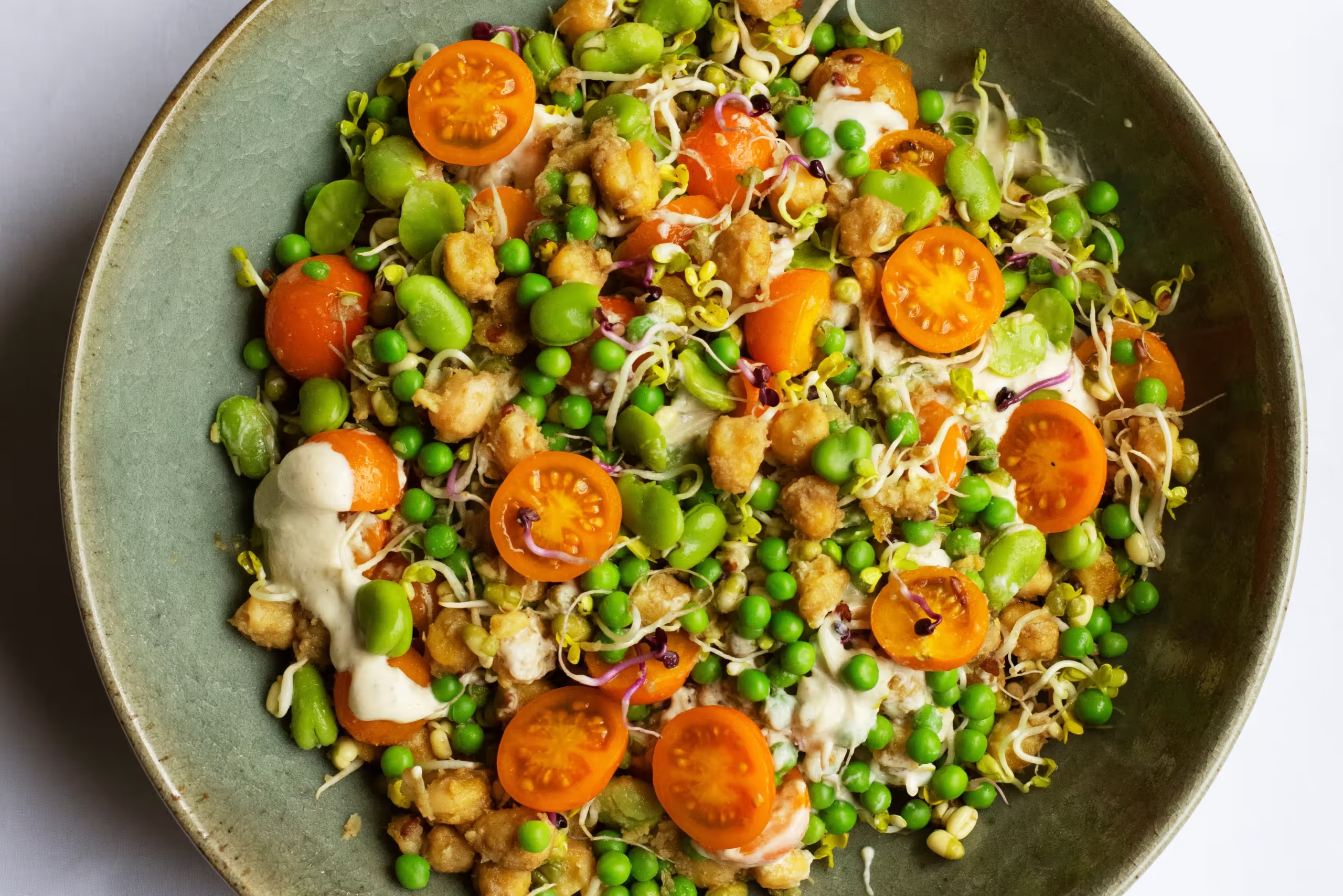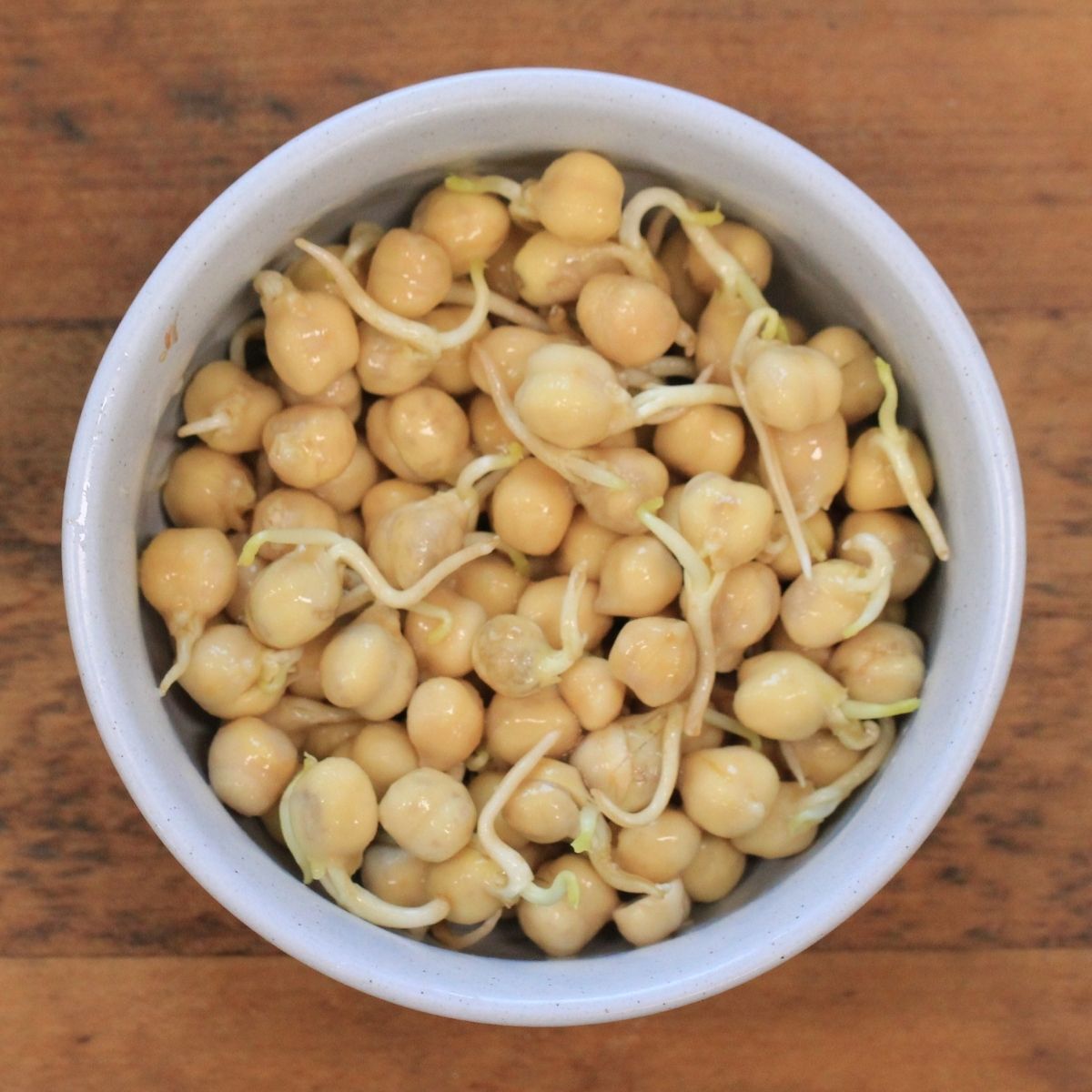What is sprouting?
Sprouting is the process of germinating seeds—starting their growth by soaking them in water for a few days until they begin to sprout tiny rootlets.
This natural process activates enzymes inside the seed, beginning the transition from a dormant state to a living plant.

What can we sprout?
You can sprout any kind of seed, for example:
- Wheat berries (the seeds of wheat)
- Kidney beans
- Mung beans
- Chickpeas
- Lentils
- …
Other seeds and legumes could work too.
Generally speaking, if it’s a whole seed, you can sprout it.

Personally I’ve sprouted soybeans, black beans, green peas, chickpeas, and linseeds. They all sprouted well, and tasted delicious too!
The process takes 2-4 days.
Here are green pea sprouts after 3 days of sprouting:

What are the benefits of sprouting?
Sprouting has multiple nutritional benefits:
- Stored starch and fatty acids are converted into proteins and vitamins.
- Sprouting activates enzymes, like phytase, which breaks down phytates (compounds that block nutrient absorption).
- The process softens the seed, making it easier to grind and digest.
- Compared to flour from unsprouted seeds, sprouted grain products are less allergenic and more nutrient-dense.
In summary, sprouting significantly increases seeds and legumes’ nutrient availability and digestibility.
Our body can more easily absorb the nutrients in seeds and legumes after they are sprouted.

The Science of Sprouting
Seeds are built to store nutrients securely, locking them in with chemical binders and a tough outer shell.
When we soak seeds, moisture triggers germination, which activates the seed’s own enzymes.

One important enzyme, phytase, breaks down phytates, which otherwise bind up minerals like iron, zinc, and calcium.
This enzymatic activity:
- Softens the seed (physically)
- Unlocks nutrients (chemically)
- Transforms starches and fats into proteins and vitamins (biochemically)
It’s like nature’s own little nutrient boost machine—just add water and time.
“Moistening the seeds for a few days activates the plant’s own enzymes—including phytase, which digests phytates—to soften the seed, free up bound nutrients, and even create new ones by converting stored starch and fatty acids into proteins and vitamins.”
From Deep Nutrition by Catherine Shanahan
How to Sprout at Home?
- Choose Your Seeds – Use whole seeds like wheat berries, lentils, kidney beans, or chickpeas.
- Soak – Place seeds in a jar and cover them with water. Let them soak overnight or up to 12 hours.
- Drain and Rinse – Drain the water and rinse the seeds thoroughly. Cover the jar with a breathable, bug-proof cloth.
- Repeat Daily – Rinse and drain the seeds once or twice a day. Keep the jar in a cool, dark place.
- Watch for Sprouts – In 1–4 days, you’ll see tiny white rootlets—your seeds have sprouted and are ready to use!

How Long Does It Take to Sprout Legumes (green peas, chick peas)?
- Soak Time: 8–12 hours in clean water
- Sprouting Time: 2–4 days to see visible sprouting (tiny white rootlets)
- Ideal Consumption Window: Day 2–4
By day 2, they’re crunchy, slightly sweet, and safe to eat raw or cooked.
By day 3 or 4, they’ve reached peak digestibility and nutritional value for most people.
By day 5–6, they start to green up and become more “shoot-like” in flavour and texture.
The texture gets grassier, and nutrient profile begins shifting more toward leafy greens.



Nutritional Changes Over 7 Days of Sprouting
Here’s a general outline of key nutritonal changes during sprouting:
| Stage | What’s Happening Nutritionally |
|---|---|
| Day 0–1 (Soaking) | Soaking activates enzymes and starts water absorption. |
| Day 2–3 (Sprouting Begins) | Big drop in phytates (anti-nutrients), freeing up iron, zinc, calcium. Digestibility improves. |
| Day 3–4 (Peak Sprout) | Vitamins C, B-complex, A, and antioxidants content rises. Some starch is converted into simpler sugars for energy. |
| Day 5–6+ (Greening) | Chlorophyll starts forming as green shoots appear. More fiber, and antioxidants |
| Overall | Easier to digest, and higher bioavailability of nutrients |
🍽️ Bonus Tip
Sprouted green peas are super tasty—crunchy with a mild sweetness. Great in:
- Stir-fries (lightly sautéed)
- Fresh salads
- Grain bowls
- Blended into dips (like a sprouted pea hummus!)

